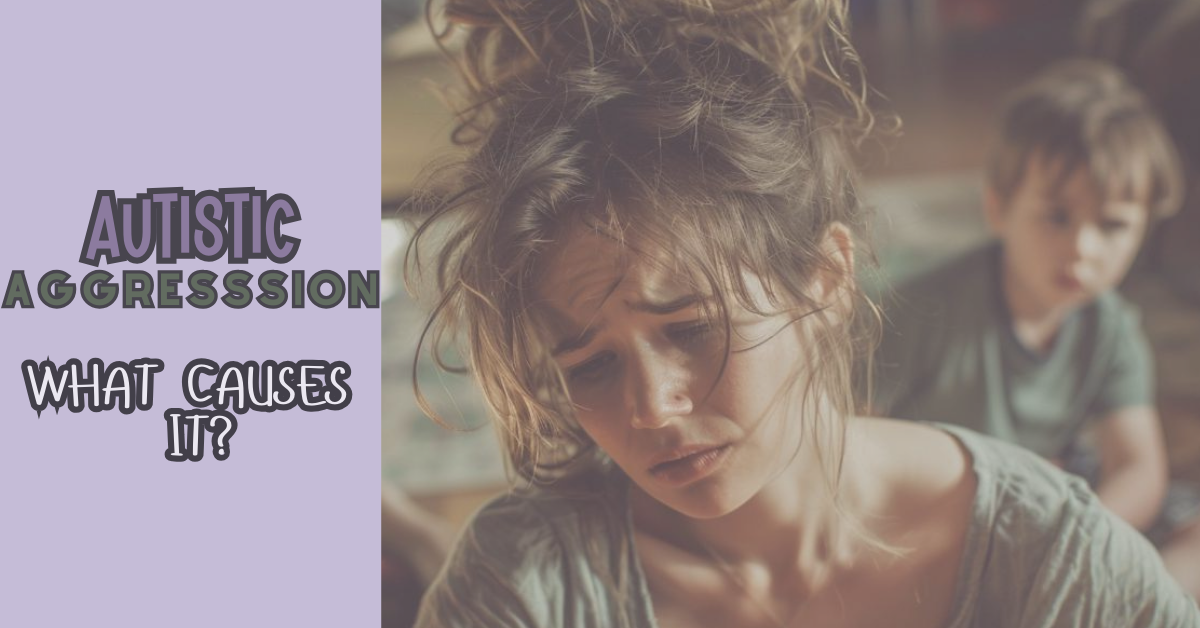Aggression in autistic children is more common than most people realize, especially for kids who are nonverbal or struggle to communicate. As the mother of a child on the spectrum, one of the hardest things I’ve lived through is being the direct target of that aggression. You’re exhausted, you’re hurting, and you’re standing there asking yourself the big question: Why? Why is this happening?
The truth is, there are reasons — and understanding the link between autism and aggression can help you respond with more confidence, less guilt, and (eventually) fewer explosions.
Why Are Children on the Spectrum Aggressive?
Aggression in autistic children can be confusing, scary, and honestly heartbreaking. You’re looking at someone you love more than anything in the world, and they’re hitting, biting, kicking, screaming — and you feel helpless. But aggression is almost always communication. It’s not “bad behavior for no reason.” It’s a response to something that feels unmanageable in their body or environment.
With my son, the pattern is pretty clear. I’d estimate that about 75–80% of his aggressive episodes come from communication problems — he can’t tell me what he needs. The other 20–25% usually show up when he’s in pain or doesn’t feel well. Those needs are often invisible to everyone else, but he’s feeling them loudly. Because he can’t explain, the only tool left is anger.
Let’s walk through some of the most common causes of aggression in autistic kids. Finding the “why” is the first step toward calming it.
Communication Difficulties
One of the biggest triggers for aggression in autistic children is difficulty communicating. Many kids on the spectrum have limited or unreliable speech, so they can’t easily say “my stomach hurts,” “I’m done,” “you’re too loud,” or even “no.”
Now imagine needing something desperately and being unable to get the grown-up in front of you to understand you. That kind of frustration builds and builds until it explodes. What looks like “anger” is often “I’m begging you to fix this and you’re not fixing it.”

The information in this post is for educational purposes only and should not be considered medical advice. Please consult your child’s physician before implementing any strategies mentioned here.
Sensory Overload
Many autistic children experience the world more intensely than neurotypical children. Sounds that seem normal to us may feel like alarms in their ears. Lights may feel blinding. Certain textures may make their skin crawl. Even smells can be overwhelming.
When their nervous system gets flooded with too much input, some kids go into “fight” mode. That “fight” can look like hitting, throwing, screaming, pushing, or completely melting down. It’s not about being “bad.” It’s about survival. Their body is screaming, “Make it STOP.”
Sensory break idea: For my son, sensory deprivation helps. At school, access to a sensory room is crucial. At home, we do blankets over the body to block out light and sound for a few minutes. Noise-canceling headphones are also lifesavers when the world is “too loud.”
Frustration and Anxiety
Kids on the spectrum often depend on routine to feel safe. Knowing the schedule (what’s happening, when it’s happening, where they’re going, who will be there) gives them stability. When that routine gets changed unexpectedly — a canceled outing, a substitute teacher, a store being crowded when it’s usually empty — anxiety can spike fast.
That anxiety, plus the inability to say “I’m overwhelmed and scared,” can turn into aggression. It’s not defiance. It’s panic in a body that can’t self-regulate yet.
Many autistic kids also get frustrated with their own limitations: not being understood, not being able to do what other kids do easily, not being able to explain what they’re feeling. That frustration can boil over in seconds.
As one example: something as simple as a favorite snack being out of stock at the store can cause a total meltdown, not because of “bad behavior,” but because their brain had locked onto that one safe, predictable thing — and it’s gone.
If you’ve lived this, you know.
Seeking Attention
Sometimes, aggression is about attention — but usually not in the manipulative way people assume. If a child can’t ask for help, touch, comfort, or interaction in a typical way, they may figure out (over time) that hitting or screaming always gets a response.
One way to tell if this is what’s happening: leave the room for a moment. If your child stops immediately or follows you just to keep the behavior going, it may be attention-driven. If they stay upset whether you’re in the room or not, it’s probably not about attention — it’s about overwhelm.
In my son’s case, the aggression continues whether I’m standing next to him or in the next room. That tells me he’s not “performing” for attention. He’s drowning and has no other way to say “help me.”
Need for Control
Autistic kids often live in a world that doesn’t feel built for them — and that can feel scary and powerless. Aggression can sometimes be an attempt to create control in chaos. If they can’t control the environment, the noise level, the routine change, or even their own body, they may lash out to try to force things back into a place that feels predictable.
To us it looks like “he’s being difficult.” To them it feels like, “Everything is spinning and I need something to stop right now.”
Physical Discomfort or Illness
This one is huge and so often overlooked. Aggression can be a pain response.
Your child might be dealing with a headache, stomach pain, reflux, constipation, migraine, ear infection, or even sensory irritation from clothing — and because they can’t tell you “my ear hurts,” it just comes out as rage.
I cannot tell you how many times we’ve ended up at the pediatrician or urgent care because my son was suddenly aggressive and miserable, and I couldn’t figure out why. More than once, he turned out to have an ear infection with zero obvious symptoms — no fever, no tugging his ear, nothing. His only way to say “I’m in pain” was to come after me physically. Please do not feel silly asking a doctor to check. You are not “overreacting.” You are advocating.
Modeling Behavior
Kids learn what they see. If they see aggression in their environment — at home, at school, even from stressed-out adults who yell or grab — they may mirror it. They also learn from results. If pushing, hitting, or screaming makes something stop, the brain remembers that as a tool.
This is one reason why spanking or swatting a child who is already aggressive usually backfires. You might think you’re “teaching a lesson,” but what they often absorb is: “When I’m upset and overwhelmed, I should hit.” You don’t want that message reinforced.
The Target of the Aggression: You
Now let’s talk about something that almost no one prepares you for: why the aggression is directed at you — the parent, usually mom.
My son is a complete mama’s boy. I am his safe person. He needs me nearby to function, and being away from me too long will send him into full panic attacks and meltdowns. Because I am his safe place, I am also the person who gets the aggression.
That feels impossible to process at first. You look at this child who adores you and wonder, “Why is he hurting me?” You ask, “Am I doing something wrong?”
Here’s the truth that took me years to accept: He targets me because he loves me and trusts me the most.
He is exploding in front of me because he knows I will not abandon him for it. I am the person he believes can “fix it.” He is begging me, in the only language his body has in that moment, to help him regulate.
Does that make it easier to live through physically? No. But emotionally, it helps you shift from “my child is attacking me” to “my child is drowning and I am the only life raft he thinks he has.”
Your child is trying to communicate with you, even if the communication looks like kicking and screaming.
It Will Be Alright
I know it doesn’t always feel like it, especially on the days you end up bruised, overstimulated, ashamed, and crying in the bathroom. But it will be alright.
You are allowed to take a break. You are allowed to lock yourself in the bedroom for five minutes to cry and breathe. You are allowed to call someone and say, “I need you to come sit with him because I am not okay.”
Your mental health matters. Your safety matters. You cannot show up for your child if you are completely wrecked. Taking care of yourself is not selfish — it’s part of taking care of them.
And please remember this part: Your child does not want to hurt you. Your child is not your enemy. Your child is overwhelmed, scared, overstimulated, in pain, or unable to communicate — and you are the safest person to fall apart on.
That is how deep the bond is.
Understanding these root causes is the first step in managing aggression in autistic children. This behavior is not a sign that you’re a bad parent or that your child doesn’t love you. It’s a sign that something in their world is too big for them to handle alone.
With time, support, and the right tools, you can work on identifying triggers, protecting your peace, and helping your child find safer ways to communicate. You are not alone in this — even if it feels like you are.



Leave a Reply